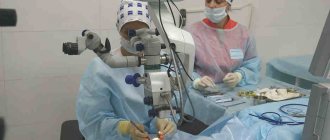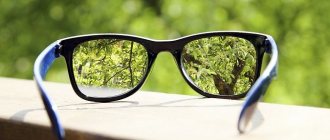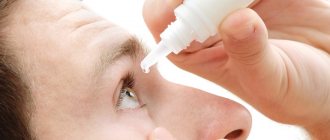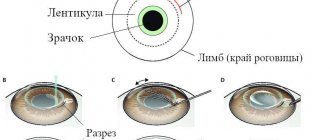Postoperative period
Vision correction using the PRK method and Lasika are quite complex surgical interventions that require a lot of skill and effort on the part of specialists. In addition, this procedure requires sufficient effort, preventive and rehabilitation measures to achieve optimal results in the recovery period.
The postoperative period requires many restrictive measures that must be followed over a long period, such as a healthy diet, limiting heavy lifting, and long-term use of moisturizing drops. Also, for complete rehabilitation of the patient, it is necessary to resort to the use of additional methods to relax the eyes during long-term work.
These methods include therapeutic gymnastic exercises that allow you to restore the functioning of the optic nerves and prevent complications that develop after laser vision correction. The main properties inherent in gymnastic exercises after vision correction are:
- restoration of gaze focusing;
- relaxation of the eye muscles;
- complete restoration of vision;
- improving blood circulation in the tissues around the eyes.
Gymnastic exercises can not only restore the activity of the optic nerve, but also prevent the development of diseases such as cataracts and severe myopia.
Physical activity after surgery
The first few days after the laser procedure, the patient must completely avoid all possible stress. During this period, the cornea of the eye is still very vulnerable and easily perceives any infection.
One week after surgery, you can begin to do light exercise. The duration of such classes is no more than 15 minutes a day.
After two weeks, you can start fitness, yoga and aerobics. However, physical activity and duration of exercise should be increased gradually. Also, after 14 days you can start dancing. But not sports ones, during which the dancer receives a lot of physical activity.
Only after the end of the rehabilitation period are sports such as weightlifting, martial arts, bodybuilding, and powerlifting allowed. This is explained by the fact that they require great physical strength and muscle tension throughout the body. Such efforts negatively affect the condition of the eye apparatus. When practicing martial arts, there is the possibility of physical contact. In turn, this increases the risk of eye injury and dust and debris getting into them.
If you have any questions or concerns, be sure to contact your ophthalmologist. The rehabilitation period is different for everyone. And only a medical specialist can give accurate answers to your questions.
Do you suffer from farsightedness or nearsightedness? Contact us - https://smileeyes.ru. We will help you restore your vision and see all the colors of life! +7
Attention! There are contraindications. Consult your doctor.
Health to you and your eyes and subscribe to our channel.
Source
Exercises
The early postoperative period requires limiting physical activity and increasing stress on the eyes and the entire body as a whole. Unfortunately, it is not always possible to fulfill all the specialist’s plans, since many patients are working and cannot provide themselves with an ideal postoperative regimen. For this case, special eye exercises have been developed to relieve stress on the muscular system and reduce the risk of complications.
The basic rule for performing gymnastic exercises in the recovery period is the regularity and frequency of their use - the more often the exercises are performed, the better.
The highest quality and most productive, and most importantly simple, exercises performed in any conditions and place are:
- frequent blinking of the eyes for 15-20 seconds - this exercise allows you to maximally relax the muscle structure of the eye and relieve tension;
- rapid movements of the eyeballs up and down, left and right for 20 seconds will improve blood circulation in the visual vessels;
- changing focus - first look into the distance for a few seconds (for example, what is happening outside the window), and then focus on an object nearby. For optimal effect, you can focus your gaze on an outstretched finger or an object at hand (pen, pencil, etc.) This task will reduce eye strain, so it should be performed every 30-40 minutes during the working day;
- sitting with your eyes closed for a few minutes also has a positive relaxing effect.
You should not overstrain your eyes when completing tasks. If your eyes become tense after training, you should stop performing further exercises and let your eyes rest closed.
Gymnastics after laser correction will help you replenish your strength and also increase your body’s resistance to negative factors. To achieve the best effect, experts advise adhering to a healthy lifestyle and following the necessary treatment and rehabilitation procedures.
Sports after laser vision correction
“After the operation it will not be possible” ... - and then follows a long list of prohibitions, restrictions, boundaries and taboos. The situation is probably familiar to any adult, and at the current level of development of medicine is almost inevitable. However, giving up suicidal smoking or alcohol abuse, being careful when lifting weights or maintaining a proper sleep schedule - these principles can keep you healthy not only in the postoperative period.
Now we will talk about what will be possible and what will not be possible after excimer laser vision correction. First of all, let's talk about sports and just physical activity.
We read something about this or heard from doctors, we feel something instinctively: our visual organs really don’t like physical overload. This is true. The optical-mechanical structure of the eye is too thin, complex, fragile and, we add with a sigh, imperfect (as, for example, the outstanding scientist Helmholtz believed, who reproached God for his poor knowledge of optics). Constant excessive stress that exceeds the body's calculated capabilities, as well as any monotony, daily fixation of the gaze on one object for many hours - all this will inevitably affect the health of the eyes. But if we talk about the postoperative periods (and not only in ophthalmology), here the main concerns of patients are traditionally associated with “unraveling sutures”, “incomplete healing”, “opening bleeding”, etc. How justified are these alarming expectations in the case of laser vision correction?
First of all, let us imagine once again what the operation itself consists of. The upper layers of the transparent cornea, which serves as mechanical protection for the thin structures of the eye, are not exposed to any impact - they are carefully folded back and then returned to their place in their original form. The required, anatomically and optically correct shape is given to the middle layers: the laser beam instantly evaporates those microscopic irregularities and curvatures that prevent the image from focusing on the “screen” of the retina. As a result of laser correction, the optical characteristics of the eye approach or reach individual normative parameters, the maximum possible for a given patient. No stitches are used during this procedure, and there can be no bleeding here in principle, since there are no blood vessels in the cornea. In general, nothing changes in the body except the geometric shape of the cornea, so there is no need to change the usual way of life (unless, of course, it is grossly pathological). Possible complications that really can and should be prevented relate mainly to the processes of epithelization and regeneration, i.e. postoperative healing and tissue restoration; in particular, it is extremely important to prevent infection.
The few restrictions and contraindications of the postoperative period imply, first of all, reasonable caution in the first days after laser correction: refrain from visiting the bathhouse, sauna or swimming pool, from the usual eye makeup, etc. Physical activity can cause an increase in intraocular pressure, and when prescribing steroid drops, it is better to avoid overexertion (usually for 3 weeks). If sport is a profession, then, as a rule, only after a week from the moment of laser correction the patient is allowed gentle loads with their gradual increase.
With myopia, there is a high probability of concomitant retinal defects (thinning, stretching, signs of dystrophy, etc.), and statistically the degree of myopia is in direct correlation with the severity of such defects. Therefore, many patients with severe myopia, before laser vision correction, are advised to take a course of laser strengthening and healing of the retina, as well as following a number of simple recommendations (for example, avoiding vibrations, jumping, prolonged tilting of the head along with physical stress, etc.). In general, it should be borne in mind that the cornea undergoes laser correction, and problems with the retina require separate and sometimes very difficult treatment, i.e. You should not expect that excimer vision correction will automatically eliminate retinal pathology. Such a pathology is subject, at a minimum, to constant monitoring and observation by an ophthalmologist, and only in the absence of clinically significant contraindications in this area is sports activity fully permitted.
It should be especially noted that some of the limitations (or, rather, short-term inconveniences) imposed by laser correction cannot be compared with the fact that for many specialists this method is the only way to maintain a profession if it excludes the wearing of glasses or contact lenses: here include emergency rescue workers, climbers, wrestlers, boxers, military pilots and test pilots, stuntmen, etc. There are many outstanding athletes of our time, incl. world and Olympic champions, delight and surprise us with their achievements only because laser vision correction allowed them to remain in the sport.
Not very covered in the media, but quite eloquent is the following fact: the American Congress some time ago adopted a special program for financing laser vision correction for US military personnel. In this country, as you know, they know how to count money and do not waste it (especially since we are talking about tens of millions of dollars); the feasibility of allocating such funds was justified very competently. Indeed, in the conditions of modern warfare, a soldier with poor vision, wearing glasses or contact lenses has a significantly lower chance of survival and successful completion of a combat mission. At the same time, up to 40% of US citizens who consider military service as their potential profession suffer from myopia, farsightedness, and astigmatism to varying degrees.
But, of course, not only representatives of extreme professions turn to laser vision correction, but also many famous musicians, actors, politicians... not to mention the millions of so-called ordinary people all over the planet who, thanks to the excimer laser, have acquired a completely new, clear and clear look to the world.
Recommendations and restrictions after LASIK
The quality of vision after the intervention may change, the patient sees better or worse. These fluctuations are not significant; during this period it is necessary to wear sunglasses. You can drive a car in 4-5 days, after the power of vision stops changing.
Quality testing
vision after LASIK surgery is performed on the 7th day, then once a month. The examination can be carried out by an ophthalmologist at your place of residence. Then a patient who has undergone vision correction surgery needs to see a doctor once a year.
In the postoperative period, the patient is prescribed eye drops, these are usually antibiotics, which he must use for 10 days. The composition of the drops is selected individually depending on the patient’s condition. Eye drops are applied according to a strictly defined scheme. In addition to anti-inflammatory drops, a moisturizing gel may be prescribed, which is instilled during the first month after surgery.
When instilling or administering a medicine, it is important that the pipette is disinfected; do not touch the cornea with the pipette
What other restrictions must be observed? You cannot:
- Strain your eyes for a long time by reading books, watching TV, sitting in front of a computer monitor;
- Press on the eyes;
- Rub your operated eyes and touch your eyelashes;
- Squint your eyes too hard.











